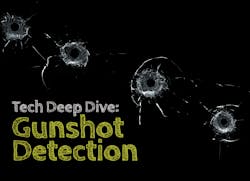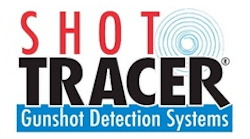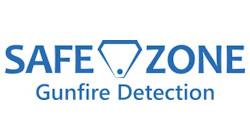Though the first gunshot detection system was created in the 1990s, militaries have been using technology to determine the origin of artillery or gun fire since World War I – when shot detection technology used by soldiers included microphones, headphones and stop-watches. Today, the technology and the application of gunshot detection looks a bit different.
Many of the gunshot detection systems currently available were first designed for and used by the military, but have since been adapted for use in the civilian world. They employ acoustic and infrared sensors and can integrate with a facility’s video surveillance and access control systems.
Gunshot detection systems and sensors can automatically generate a phone call or text message to onsite security and local police dispatchers to notify relevant personnel that a shot has been fired or that an explosion has just occurred. Some shot detection systems use artificial intelligence, machine-learning and a library of hundreds of sounds to help reduce false alarms and increase accuracy.
Today’s gunshot detection systems can reduce police and security response times, which is why schools, corporations, airports, hotels and municipalities are considering purchasing gunshot detection systems as part of their active threat and emergency response plans.
Acoustic Detection and Localization
Most gunshot detection systems depend on acoustic sensors to detect when a gunshot or explosion occurs. Multiple acoustic sensors are used to detect the sound of a shot or explosion and alert local law enforcement and/or police dispatchers, effectively automating the initiation of a 911 telephone call. Campus security officers and other key personnel may also receive a call or text message notifying them of the event.
According to Kathleen Griggs, President and CEO of Databuoy Corp., there are several different brands and kinds of acoustic gunshot detection systems available on the market today, with each offering a relatively unique kind of technology that is best-suited for specific environments. The range of each sensor differs, as does the technology used in each manufacturer’s version.
A Databuoy sensor includes four acoustic “listeners” that help to both detect a shot and pinpoint the location of the shooter. Two sensors cover each area that needs to be secured and both sensors have to register a sound as a gunshot. “Our Shot Point gunshot detection system has a 100-percent shot detection rate because we use two sensors for each area,” Griggs explains. “Our system can tell the difference between an echo, sound bounce and multiple shots.”
When security officers are notified of an explosion or shooting, Databuoy’s Know When It Counts Application software can help pinpoint the location of the shooter using acoustic data from the sensors and geometric calculations that provide the location of the bullet, origin and trajectory. This information is transmitted to security officers and emergency responders so that they are better able to immobilize the shooter.
Air Pressure Sensors
Shot Tracer’s gunshot detection sensors, which are especially well-suited for the detection of small arms fire, use a specialized air pressure sensor and microphone to detect and locate gunshots. These sensors can detect shots that are fired, for example, from around a corner in a corridor or from inside a jacket.
Shot Tracer’s Eagle AP indoor and Hawk outdoor sensors integrate with a facility’s existing alarm panel via contact closure outputs. When a shooting takes place, the sensors send an alert to the alarm panel and turn on the building alarm. A Verizon (or Vodaphone) data modem is built into Shot Tracer’s IP sensors so that when a gunshot occurs, the alert is transmitted to a cloud-based server, which then sends an alert to a security officer’s cell phone or to the local emergency dispatch.
“Every minute counts when it comes to gunshot detection,” said Allan Overcast, CEO of Shot Tracer. “It takes on average of six minutes for someone to call 911 when a shooting occurs. With Shot Tracer, it takes five seconds for safety officers to receive an alert that a shooting has occurred and where it has happened.”
Many gunshot detection systems require a network connection, which could potentially be problematic during an active shooter event or terrorist attack. Shot Tracer’s AP gunshot detection sensors don’t require a connection to a network infrastructure. They are self-contained and the data gathered by the sensors does not need to be off-loaded to a server, which also eliminates additional points of potential failure. Shot Tracer sensors use signal processing to transmit information, which means they can also be integrated with access control systems, which is crucial in containing an active shooter to a limited area.
Combining Acoustics with Infrared and AI
Gunshot detection systems such as AmberBox include sensors with both acoustic and infrared sensing capabilities. Artificial intelligence capabilities can also reduce false alarms significantly.
Sensors that include infrared technology detect what’s known as muzzle flash – the visible light created when a shot is fired that is caused by the combustion of gunpowder mixing with the ambient air. The sounds detected by the sensor(s) are compared with gunshot sound samples and other sounds to confirm that the sound was a gunshot and not something else, such as thunder or someone dropping a large object.
“Each sensor contains a library of 3,000 gunshot samples and other sounds to which the detected sound can be compared,” explains James Popper, CEO of AmberBox. “In a matter of seconds, the sensor analyzes infrared and acoustic data and determines whether a gunshot has been fired.”
When the gunshot has been detected and verified, AmberBox sensors send an alert through a wireless MESH network to automatically initiate a 911 call to the local emergency dispatch, while also notifying onsite security officers via email, text message or phone call.
Shot Spotter, winner of the 2018 AST Homeland Security Award for Best Shot Detection System and one of the most well-known manufacturers of gunshot detection systems, also makes sensors with both acoustic and infrared detecting capabilities and artificial intelligence. In order to reduce false alarms, once an incident has been determined to likely be a gunshot, the data from the sensor(s) then is sent to Shot Spotter’s monitoring center (Incident Review Center) for analysis by a human. If the analyst determines that the event is a gunshot and not a false alarm, he/she uses the Shot Spotter system to send alerts to local law enforcement and emergency dispatchers.
Similarly, the Safe Zone Gunfire Detector, introduced last year at CES and featured at ISC West in 2019, uses a combination of acoustic and infrared detection; as does the Guardian Indoor system from Shooter Detection Systems.
Integration with Other Systems
Gunshot detection systems vary in their integration capabilities. They may be integrated with some combination of video, access control, PSIM and mass notification systems, and with panic alarms, public address systems, drones, license plate readers, predictive policing software, crime dashboards and geospatial software.
Louroe Electronics’ Gunshot Detector software, for example, integrates acoustic detection with IP cameras and video management software (VMS) to use analytics to classify and verify a gunshot and then trigger notification through the VMS or other sources.
Other manufacturers are integrating multiple technologies into a single piece of hardware. Databuoy, for example, is currently working with partners in the smart city world and lighting industry to integrate its acoustic sensors with luminaire fixtures. Shot Tracer’s Eagle Eyes combines gunshot detection with high resolution still images that are sent to selected recipients when a shooting occurs.
Choosing a System
According to Chris Connors, CEO of Shooter Detection Systems, independent third-party certification can help narrow the field when it comes to evaluating gunshot detection systems and their technology. Its Guardian system was approved by the Centre for the Protection of National Infrastructure – a U.K. government authority – achieving a 100-percent detection rate and a zero percent false alert rate in performance trials. The U.S. Department of Homeland Security also certified Guardian under the SAFETY Act (Support Anti-terrorism by Fostering Effective Technology), and the Australian Government’s Security Construction and Equipment Committee has awarded the Guardian a Security Level 4 Certificate of Approval.
Connors sees third-party certification and standardization as the precursors to federal standards for gunshot detection systems, which are on the horizon. He and Shooter Detection Systems are currently working with the National Fire Protection Association (NFPA) on developing standards for gunshot detection systems, namely NFPA 3000, the Standard for an Active Shooter/Hostile Event Response (ASHER) Program.
Catherine Berce is the owner and lead writer for Berce Creative, a provider of writing services including marketing communications, social media content, thought leadership articles and more. Learn more at http://bercecreative.com.




